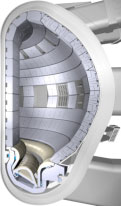| Posted: March 18, 2009 |
The future of fusion: are diamonds forever? |
|
(Nanowerk News) Increasingly, we live in a time that is obsessively motivated towards alternative energies, as global warming and its effects begin to dominate the world’s collective consciousness. Favour is irreversibly shifting away from ‘traditional’ fossil fuels as it becomes clear that the future of energy production must tick all the boxes; abundant, financially viable and, above all, green. As our understanding and priorities have shifted, scientists at the London Centre for Nanotechnology and across the world have been working to establish one extremely high profile alternative energy source as a major potential player: fusion.
|
|
Safer than nuclear fission, cleaner than fossil fuels and theoretically more efficient than either; nuclear fusion is an almost irresistible proposition although not one without considerable challenges.
|
|
Fusion occurs naturally in the Sun’s core at the relatively mild temperatures of 10 million degrees. In the laboratory, however, we are not capable of reproducing the pressures atomic nuclei experience at the centre of the sun. In order to fuse nuclei here on Earth the pressure deficit must be counteracted by raising the temperature. A plasma of tritium and deuterium nuclei stripped of their electrons is held at around 100 million degrees and forced together by an extremely intense magnetic field generated in a specially designed chamber, known as a Tokamak.
|
|
The JET Tokamak in the UK has run successful controlled test reactions under these conditions, laying strong foundations for the scientific feasibility of fusion. To date the reactions have only been maintained on time-scales of around a second. The next massive step is to achieve sustained reactions and develop the technology required to control and safely manipulate the plasma, establishing a practical basis for fusion as an energy source. The problems to be faced are myriad, primarily in developing materials able to perform in this most demanding of environments.
|
 |
| Cross section of a Tokamak. The plasma made of Tritium and Deuterium gases is kept inside the reactor chamber by incredibly strong magnetic fields
|
|
Materials forming the first wall of the reactor, those coming into contact with the plasma, must be able to withstand extraordinarily high mechanical and thermal stresses and levels of radioactivity beyond anything otherwise experienced. The key to developing the best materials solutions lies in proper understanding of their response on an atomic level. To this end, Dr Dorothy Duffy and a team of researchers at the London Centre for Nanotechnology are working with scientists at Culham Science Centre in Oxfordshire, run by the EURATOM/UKAEA Fusion Association, investigating radiation damage in those materials that represent the most promising future for fusion research.
|
|
The engineering challenge goes beyond assessing whether a substance will crack, melt or fail under these stresses and into new territories. Focus has to be on maintaining the conditions of the plasma, which means that any loose particles of material that end up in the reactor must leach as little energy as possible from the surrounding plasma in order to sustain the requisite temperature for fusion. A realistic design for a power plant must also incorporate measures to contain any potentially harmful by-products of the reaction.
|
|
The reactor is fuelled by extremely radioactive substances which as well as producing alpha particles, helium nuclei, in the reaction, also releases a vast amount of high energy neutrons. These can cause unforeseen amounts of damage to materials comprising the reactor and the power plant itself. The group at the London Centre for Nanotechnology is modelling the trails of defects left in the wake of the particles as they pass right through those materials directly encasing the plasma and on into the main structure of the experimental facility. The understanding gleaned from simulations such as these goes towards suggesting more and more effective reactor materials such as nano-structured diamond and tungsten, whose unique properties the team at the London Centre for Nanotechnology are keen to investigate and exploit.
|
|
There is particular interest surrounding diamond as a candidate for the lining of the divertor, the point on the reactor wall that will actually meet the plasma. Diamond is incredibly strong due to the configuration of carbon atoms in its crystalline structure and the covalent bonds between them, and can withstand high temperatures due to its ability to readily conduct heat. However, its behaviour under such phenomenal levels of irradiation is yet to be fully understood. The neutrons produced in the reaction are of sufficiently high energies to overcome the bonds holding the carbon atoms together in diamond and to potentially change its fundamental structure.
|
|
Research at the London Centre for Nanotechnology is delving into just what can be expected from diamond in such an environment and highlights the reasons that full understanding of this process and its effects is of such vital importance in reactor design. Simulations run by the research group model the actuation and spread of defects throughout the material are to investigate whether, under such a heavy bombardment, it is possible to irreversibly alter the arrangement of the carbon atoms into something closer resembling graphite, which is nowhere near as robust.
|
|
As the International Thermonuclear Experimental Reactor (ITER) in the south of France becomes active within the next decade, fusion will be placed firmly in the international spotlight. Research such as that being undertaken at the London Centre for Nanotechnology is asking those questions that are imperative in establishing whether or not fusion is a viable solution to an increasingly demanding energy market.
|

